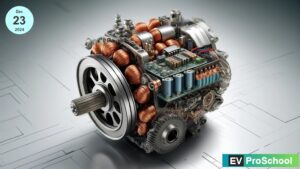EVs vs. ICE Vehicles: A Comprehensive Comparison
Electric vehicles (EVs) and internal combustion engine (ICE) vehicles each have unique characteristics in terms of drivetrain components, efficiency, emissions, and maintenance requirements. With the rapid development of EV technology, understanding the differences between these vehicle types has become essential for those considering a switch to electric transportation. This article breaks down the key distinctions between EVs and ICE vehicles in terms of drivetrain design, efficiency, environmental impact, and maintenance needs.
1. Differences in Drivetrain Components
EVs and ICE vehicles have fundamentally different drivetrain setups. While ICE vehicles rely on multiple moving parts to produce motion, EVs offer a simpler, more efficient design.
Electric Vehicle (EV) Drivetrain
The drivetrain of an EV is streamlined, reducing complexity and improving efficiency. Key components include:
- Electric Motor: EVs use either an induction, permanent magnet, or BLDC (brushless DC) motor to produce motion. These motors can operate with high efficiency across a broad range of speeds and can deliver instant torque, enhancing acceleration and overall performance.
- Battery Pack: The EV battery pack stores electrical energy and powers the motor. Battery capacity, measured in kilowatt-hours (kWh), determines the driving range of an EV.
- Inverter and Power Electronics: The inverter converts the DC (direct current) electricity from the battery to AC (alternating current) for the motor. Power electronics control the power flow to the motor, ensuring smooth operation.
- Single-Speed Transmission: Most EVs use a single-speed gearbox or direct drive, as the electric motor can efficiently operate across a wide range of speeds without needing multiple gears.
ICE Vehicle Drivetrain
ICE drivetrains are more complex due to the nature of internal combustion and the need to translate energy from fuel into mechanical motion. Main components include:
- Engine: ICE vehicles use a combustion engine powered by gasoline or diesel fuel, producing energy through controlled explosions in cylinders. This system requires multiple moving parts, such as pistons, camshafts, and crankshafts.
- Multi-Speed Transmission: Unlike EVs, ICE vehicles rely on multi-speed transmissions to keep the engine within an optimal speed range for efficiency and performance. Transmissions require clutches, gear sets, and shift mechanisms to adjust power delivery based on speed and load.
- Fuel System: ICE vehicles rely on a fuel tank, fuel injectors, and a fuel pump to store and deliver gasoline or diesel.
- Exhaust System: ICE vehicles include an exhaust system with components like catalytic converters and mufflers to manage emissions.
Summary: EV drivetrains are simpler and contain fewer moving parts than ICE drivetrains. This streamlined setup in EVs enhances efficiency and requires less maintenance over the vehicle’s lifetime.
2. Efficiency and Emissions Comparison
Energy efficiency and emissions are two major factors that differentiate EVs from ICE vehicles. EVs lead the way in both categories, making them a more eco-friendly choice.
Energy Efficiency
- EVs: Electric motors are highly efficient, typically converting 85-90% of electrical energy into motion. In contrast, the streamlined drivetrain allows for minimal energy losses. This high efficiency translates directly to longer range per unit of energy and lower operational costs.
- ICE Vehicles: Internal combustion engines have an efficiency of only 20-30%, with a significant amount of energy lost as heat. The mechanical complexity of ICE drivetrains, combined with the friction of moving parts, reduces efficiency and contributes to higher fuel consumption.
Emissions
- EVs: Since EVs produce no tailpipe emissions, they do not contribute to air pollution during operation. When charged with renewable energy, they offer a completely emissions-free driving experience.
- ICE Vehicles: ICE vehicles emit greenhouse gases (GHGs), nitrogen oxides, and particulate matter through their exhaust systems, contributing to air pollution and global warming. Despite advancements in emission-reduction technology, ICE vehicles still produce significantly higher emissions than EVs.
Summary: EVs are significantly more energy-efficient than ICE vehicles and produce no tailpipe emissions, making them more environmentally friendly.
3. Maintenance Differences (Oil Changes, Moving Parts)
The maintenance requirements for EVs and ICE vehicles differ greatly due to their respective drivetrains and operational mechanics. Generally, EVs require less maintenance, resulting in lower long-term ownership costs.
Maintenance for EVs
- No Oil Changes: EVs do not require engine oil, eliminating the need for regular oil changes, which is a frequent maintenance task in ICE vehicles.
- Fewer Moving Parts: The simplicity of EV drivetrains, with fewer moving parts, means there are fewer components subject to wear and tear. EVs have no pistons, spark plugs, or timing belts that would require periodic replacement.
- Brake Wear: Regenerative braking in EVs reduces the reliance on traditional brake systems, meaning brake pads and rotors last longer, requiring less frequent replacement.
- Battery Maintenance: While EV batteries degrade over time, modern battery management systems (BMS) help maintain battery health, minimizing capacity loss. Most EVs come with warranties on batteries, ensuring coverage if significant degradation occurs.
Maintenance for ICE Vehicles
- Oil Changes: ICE vehicles require regular oil changes, typically every 5,000-10,000 miles, to keep the engine lubricated and prevent wear. These changes add to the cost and inconvenience of ICE maintenance.
- Engine and Transmission Wear: The numerous moving parts in an ICE drivetrain—such as the engine, multi-speed transmission, and fuel system—are subject to wear, requiring regular maintenance or replacement.
- Exhaust System Maintenance: Components like the catalytic converter, muffler, and exhaust pipes require periodic inspections and replacements due to corrosion or failure.
- Fuel and Air Filters: ICE vehicles require regular replacement of fuel and air filters to maintain engine efficiency and performance.
Summary: EVs have fewer maintenance requirements and lower ownership costs than ICE vehicles. The absence of engine oil, fewer moving parts, and regenerative braking contribute to these reduced maintenance needs.
Conclusion
Electric vehicles and ICE vehicles differ in several fundamental ways, from drivetrain components to energy efficiency and maintenance requirements. While ICE vehicles have a long-established infrastructure and familiarity, EVs are emerging as the future of sustainable transportation due to their efficiency, zero emissions, and lower maintenance needs. Understanding these differences can help consumers make informed choices based on cost, environmental impact, and ease of ownership.


